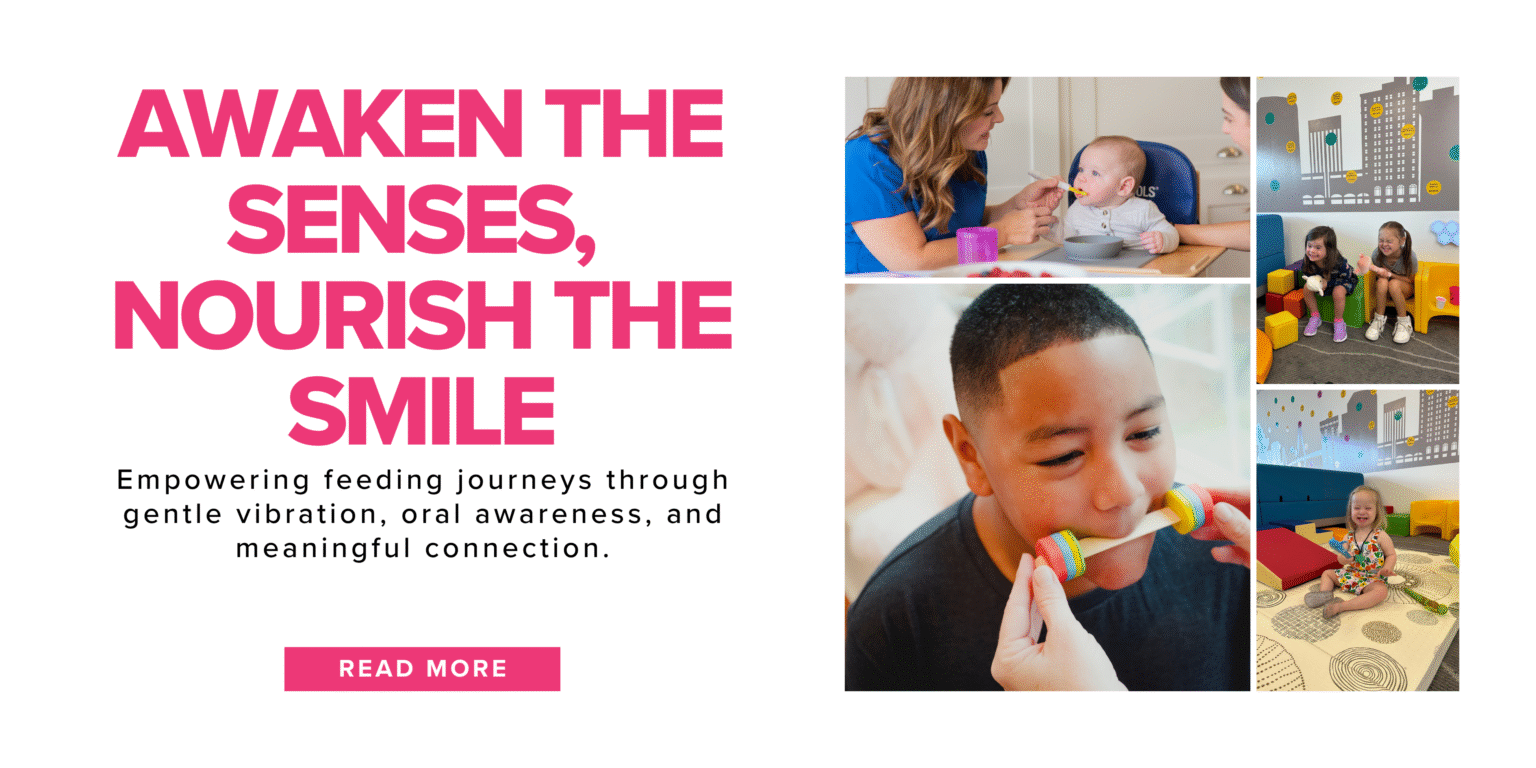NOTE: This article has been reprinted with permission from Diane Bahr of Ages and Stage®, LLC and Robyn Merkel Walsh.
Robyn Merkel-Walsh, MA, CCC-SLP & Diane Bahr, MS, CCC-SLP, CIMI
EVIDENCE-BASED PRACTICE (EBP) IN SPEECH-LANGUAGE PATHOLOGY
According to the American Speech, Language, and Hearing Association (ASHA, 2005) “the term evidence-based practice [EBP] refers to an approach in which current, high-quality research evidence is integrated with practitioner expertise and client preferences and values into the process of making clinical decisions.” Note that this approach to treatment encompasses practitioner expertise and client preferences in addition to high-quality research. In June 2011, Dr. Paul Rao (ASHA’s president at the time) said, “EBP is not about identifying the one best approach – it is about deciding which among the many acceptable options is likely to work best for a particular individual.” So, we are going to talk about acceptable oral sensory-motor treatment for speech disorders.
THE TRUTH ABOUT ORAL-SENSORY MOTOR TREATMENT FOR SPEECH DISORDERS
For many years, it was rumored that oral sensory-motor treatment was ineffective for treating the sensory-motor process of speech. Therefore, the Oral Motor Institute(OMI) was formed “to publish monographs that demonstrate the evidence base of oral sensory and motor techniques for articulation, motor speech, and feeding treatment” (Oral Motor Institute, n.d.). The OMI conducted a thorough and systematic review of the claim that oral sensory-motor treatment was ineffective in the treatment of speech problems. This process included extensive journal literature review (Bahr, 2008; Bahr, 2011, Sept.; Bahr, 2011, Nov.; Bahr & Banford, 2012) and textbook review (Marshalla, 2007, 2008, & 2012) which revealed:
- There are effective oral sensory-motor treatments for speech disorders
- There is a large body of journal and textbook literature regarding oral sensory-motor treatments for speech disorders
- ASHA supports research that provides evidence on the efficacy of oral sensory-motor treatments for speech disorders
- Oral Placement Therapy (OPT) and Phonetic Placement Therapy (PPT) are forms of oral sensory-motor treatment for speech disorders
- OPT and PPT are not the same as Non-Speech Oral-Motor Exercise (NSOME)
ORAL PLACEMENT THERAPY (OPT) AND PHONETIC PLACEMENT THERAPY (PPT)
The relatively new term Oral Placement Therapy (OPT) coined by Sara Rosenfeld-Johnson (2009) seems to be an updated version of the historical term Phonetic Placement Therapy (PPT). Both OPT and PPT use touch, movement, and tools (which include hands) to help a client attain actual speech sound production. These techniques are used when “look, listen, and do as I say” methods do not work. For example, graded sizes of Bite Blocks have been effectively used to help clients establish appropriate jaw heights as they simultaneously learn to produce front vowels and various consonant sounds (Sacks, Flipsen, & Neils-Strunjas; Bahr & Rosenfeld-Johnson, 2010; Crary, 1993, p. 224). Progressive Jaw Closure Tubes have been used to teach appropriate jaw heights and lip-rounding for back vowels as clients simultaneously learn to produce these speech sounds.
Van Riper, “a founding father of modern speech-language pathology,” described the history and use of PPT in 1954:
For centuries, speech correctionists have used diagrams, applicators, and instruments to ensure appropriate tongue, jaw, and lip placement [for speech sound production]…. [These] phonetic placement methods are indispensable tools in the speech correctionist’s kit…. Every available device should be used to make the student understand clearly what positions of tongue, jaw, and lips are to be assumed (Van Riper, 1954, pp. 236-238).
In fact, there are many forms of PPT that have been used since the inception of speech-language pathology (Marshalla, 2007, 2012). Currently, OPT and PPT are taught by Sara Rosenfeld-Johnson (2009) and Pamela Marshalla (Marshalla, 2008). However, other forms of this type of treatment include Dynamic Temporal and Tactile Cueing (DTTC), motokinesthetics, palatometry, Prompts for Restructuring Oral Muscular Phonetic Targets (PROMPT), and ultrasound imaging (Bahr & Rosenfeld-Johnson, 2010).
OPT AND PPT ARE NOT NSOME (Non-Speech Oral-Motor Exercise)
By definition NSOME (Lof & Watson, 2008, p. 394) is “any technique that does not require the child to produce a speech sound but is used to influence the development of speaking abilities” such as unrelated cheek puffing and tongue wagging. By definition OPT and PPT use touch, movement, and tools (including hands) to attain actual speech sound production. Some OPT and PPT strategies may incorporate oral, vocal, and respiratory exercise as part of treatment (when needed), but each target is a component of actual speech production.
While confused at times in the literature and perhaps in practice, OPT/PPT and NSOME are distinct entities (Bahr & Rosenfeld-Johnson, 2010; Marshalla, 2008). In OPT and PPT, a sequenced and coordinated skill set for speech production is broken down into simpler steps and then combined into the final goal (i.e., the fine-motor function of speech). Similar approaches are used in the fields of occupational and physical therapy. This is a very different process than NSOME which addresses general muscle function (if properly applied) but not speech production.
NSOME has a place in treatment. Across the literature, there seems to be general agreement that NSOME is useful for individuals with muscle function disorders (e.g., those with Down syndrome, cerebral palsy, Parkinson’s disease, etc.) in improving overall muscle function. These individuals have muscle weakness and movement problems throughout the body, and “what you see in the body is what you get in the mouth” (Overland & Merkel-Walsh, 2013, p. 73). When NSOME is used to improve general muscle function, it must be carefully chosen and systematically applied. For example, Ruscello (2008b, p. 294) stated that “there is…a small subset of clients [with velopharyngeal insufficiency] who may improve with treatment using muscle rehabilitation procedures that are task specific to speech.”
Ruscello (2008a, p. 386) also said, “It should be noted that childhood speech disorders caused by neuromuscular deficits…need to be treated accordingly.” In their survey, Lof and Watson (2008, p. 396) found that speech-language pathologists primarily used NSOMEs with children who exhibited motor speech disorders. With the exception of Childhood Apraxia of Speech, children with motor speech disorders usually have generalized muscle function problems.
While McCauley, Strand, Lof, Schooling, and Frymark (2009, p. 343) found “insufficient evidence to support or refute the use of OMEs [oral motor exercises] to produce effects on speech,” researcher Christopher Moore and his colleagues have repeatedly demonstrated (via electromyography) that the neural mechanisms and subsequent motor plans/gestures for speech and non-speech activities are different from one another (Bahr & Banford, 2012). Therefore, NSOME alone is unlikely to improve speech unless it is used with actual speech production techniques. This concept is consistent with OPT and PPT which work on actual speech production through task analysis and successive approximations when properly applied.
THE IMPORTANCE OF WORKING WITH A TRAINED PROFESSIONAL
When selecting appropriate speech treatment for an individual, it is important to be educated about the treatment whether you are a family member or a professional. The treatment needs to be evidence-based, and the therapist supplying the treatment must be properly trained.
Family members can look for professionals specifically trained in OPT and PPT. While it would be ideal if these techniques were taught at the undergraduate and graduate levels, most of this training occurs at the post-graduate level (Bahr & Banford, 2012). So, family members can look for speech-language pathologists trained in DTTC, motokinesthetics, OPT, PPT, PROMPT, ultrasound imaging for speech, palatometry, and similar “hands-on” treatments.
In thinking back to Dr. Rao’s 2011 statement: “EBP is not about identifying the one best approach – it is about deciding which among the many acceptable options is likely to work best for a particular individual.” Both OPT and PPT are viable options for speech treatment when properly implemented. Forms of PPT been used since the inception of speech-language pathology practice.
REFERENCES
American Speech-Language-Hearing Association. (2005). Evidence-based practice in communication disorders [Position Statement]. Available from www.asha.org.
Bahr, D. (2008, Jan.). A topical bibliography on oral motor assessment and treatment. Oral Motor Institute, 2(1). Available from www.oralmotorinstitute.org.
Bahr, D. (2011, Sept.). The oral motor debate – Part I: Understanding the problem. Oral Motor Institute, 3(1). Available from www.oralmotorinstitute.org.
Bahr, D. (2011, Nov.). The oral motor debate – Part II: Exploring terminology and practice patterns. Oral Motor Institute, 3(2). Available from www.oralmotorinstitute.org.
Bahr, D., & Banford, R. J. (2012, Jan.). The oral motor debate – Part III: Exploring research and training needs/ideas. Oral Motor Institute, 4(1). Available from www.oralmotorinstitute.org.
Bahr, D., & Rosenfeld-Johnson, S. (2010, Feb.). Treatment of children with speech oral placement disorders (OPDs): A paradigm emerges. Communication Disorders Quarterly, 31, 131-138.
Crary, M. A. (1993). Developmental motor speech disorders. San Diego, CA: Singular.
Lof, G. L., & Watson, M. (2008, Jul.). A nationwide survey of nonspeech oral motor exercise use: Implications for evidence-based practice. Language, Speech, and Hearing Services in Schools, 39, 392-407.
Marshalla, P. (2007, Sept.). Oral motor techniques are not new. Oral Motor Institute, 1(1). Available from www.oralmotorinstitute.org.
Marshalla, P. (2008, Apr.). Oral motor treatment vs. non-speech oral motor exercises. Oral Motor Institute, 2(2). Available from www.oralmotorinstitute.org.
Marshalla, P. (2012, Apr.). Horns, whistles, bite blocks, and straws: A review of tools/objects used in articulation therapy by Van Riper and other traditional therapists. Oral Motor Institute, 4(2). Available from www.oralmotorinstitute.org.
McCauley, R. J., Strand, E., Lof, G. L., Schooling, T., & Frymark, T. (2009, Nov.). Evidence-Based systematic review: Effects of nonspeech oral motor exercise on speech.American Journal of Speech-Language Pathology, 18(4), 343-360.
Oral Motor Institute (n.d.). Home page: Mission statement. Available from www.oralmotorinstitute.org.
Overland, L. L., & Merkel-Walsh, R. (2013). A sensory motor approach to feeding. Charleston, SC: TalkTools.
Rao, P. R. (2011, Jun. 7). Evidence-Based practice: The coin of the realm in CSD. The ASHA Leader, 16(7), 7.
Rosenfeld-Johnson, S. (2009). Oral placement therapy for speech clarity and feeding (rev. 4th ed.). Tucson, AZ: Innovative Therapists International.
Ruscello, D. M. (2008a). Nonspeech oral motor treatment issues related to children with developmental speech sound disorders. Language, Speech, and Hearing Services in Schools, 39, 381-391.
Ruscello, D. M. (2008b). An examination of nonspeech oral motor exercises for children with velopharyngeal inadequacy. Seminars in Speech and Language, 29, 294-303.
Sacks, S., Flipsen, P., & Neils-Strunjas, J. (2013, Oct.). Effectiveness of systematic articulation program accessing computers (SATPAC) approach to remediate dentalized and interdental /s, z/: A preliminary study. Perceptual and Motor Skills, 117(2). 559-577.
Van Riper, C. (1954). Speech correction: Principles and methods. Englewood Cliffs: Prentice-Hall.
AUTHORS
Robyn Merkel-Walsh is a speech pathologist who is employed by the Ridgefield Board of Education, TalkTools, as well as her own practice. Robyn is an international lecturer who specializes in muscle and motor based speech disorders, feeding, and orofacial-myofunctional disorders. She is the co-author of A Sensory Motor Approach to Feeding (2013) and the Oral Placement to Speech Kit (2011). She is the author of the 2002 SMILE (SysteMatic Intervention for Lingual Elevation) program and has published many popular articles.
Diane Bahr is co-owner of Ages and Stages®, LLC (Resources for Feeding, Speech, and Mouth Function) and the author of Oral Motor Assessment and Treatment: Ages and Stages (2001) and Nobody Ever Told Me (or My Mother) That! Everything from Bottles and Breathing to Healthy Speech Development (2010). She has taught at both the undergraduate and graduate levels and is currently an international speaker on the topics of feeding, motor speech, and mouth function. She has also written extensively on these topics.
Both authors are experienced master clinicians and Board Members for the all-volunteer Oral Motor Institute study group.



